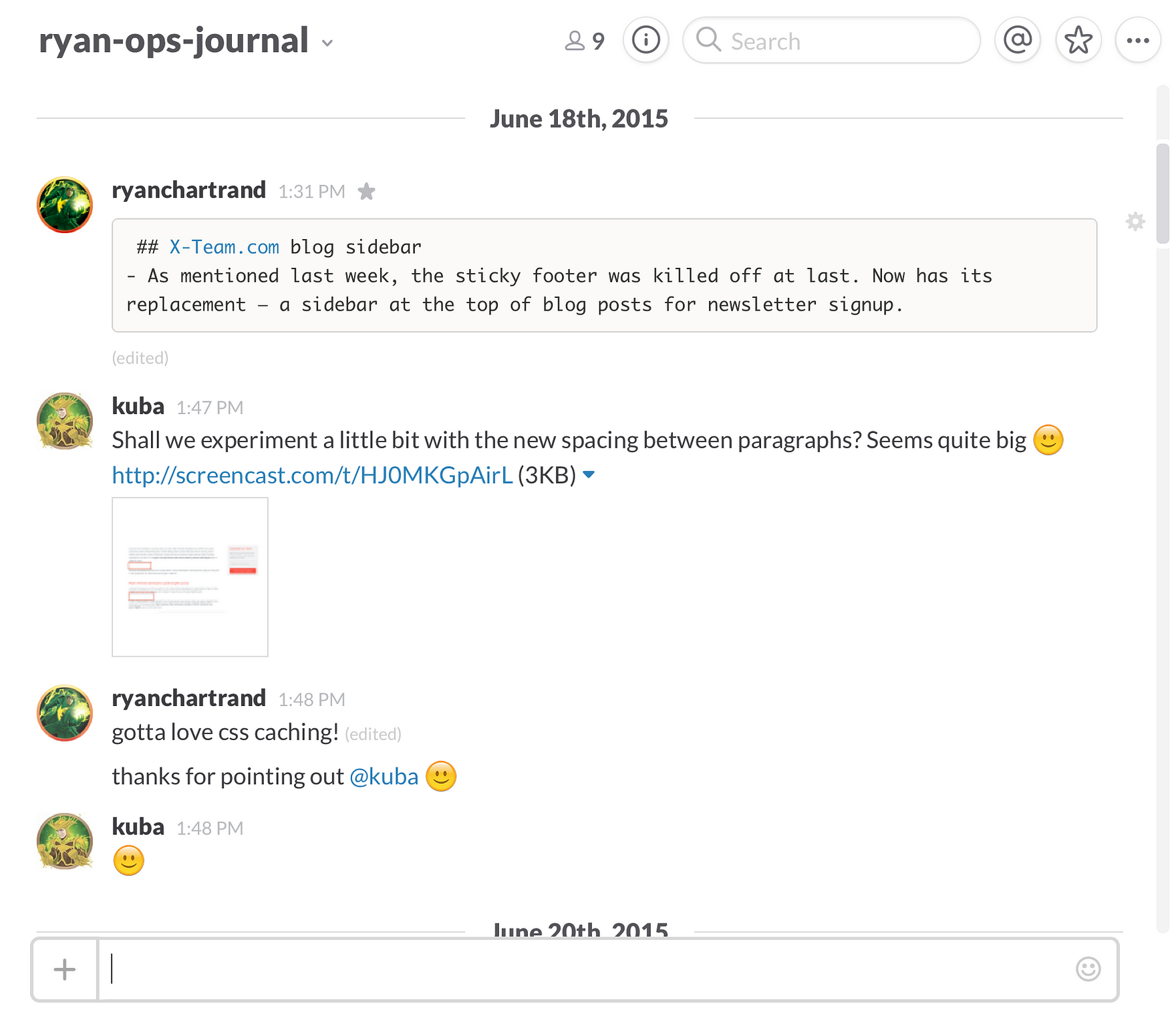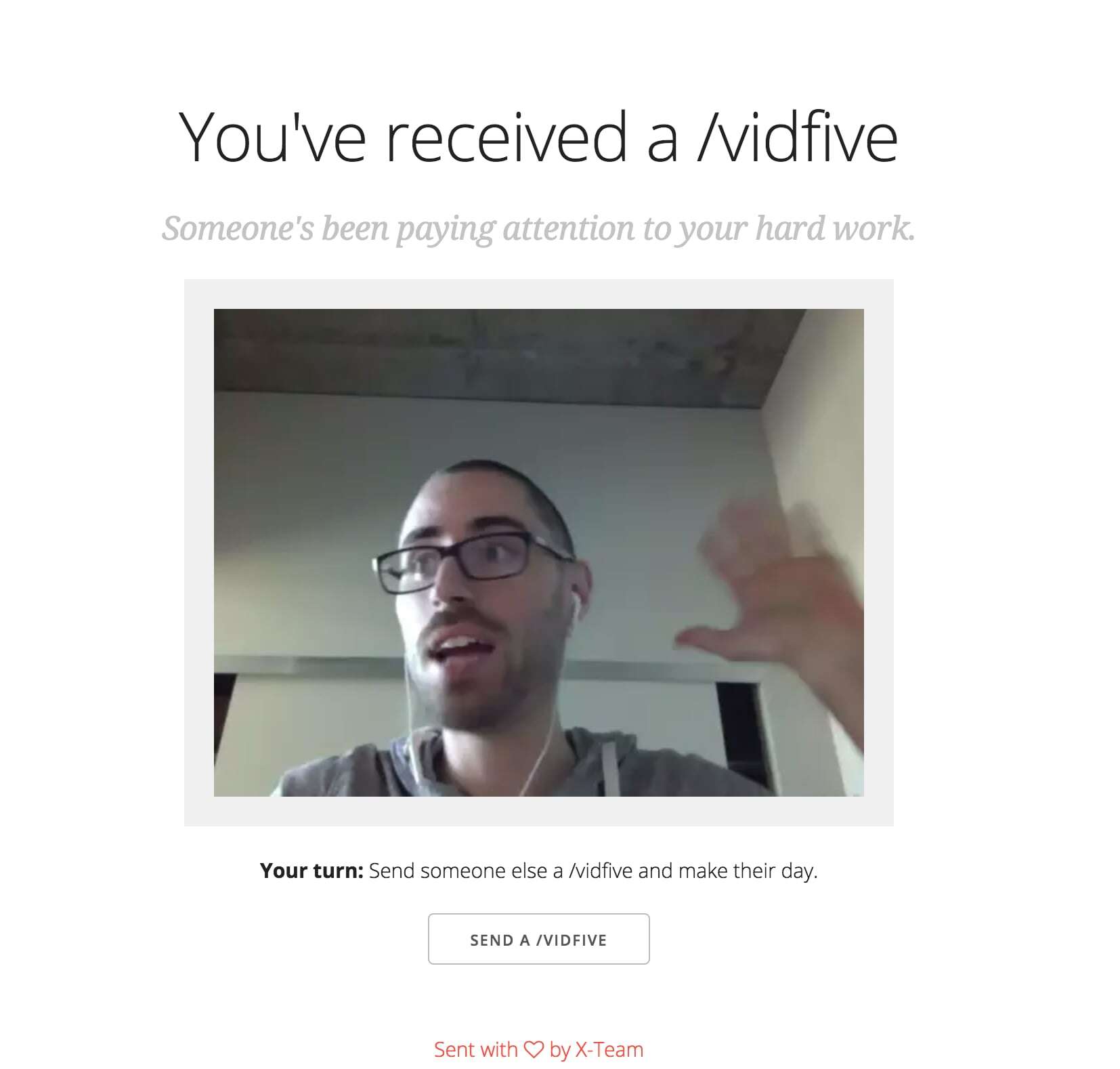
Discovering the ‘secrets’ to making a remote company operate effectively is different for every company. My company, X-Team, has been operating remotely for a decade, and we keep learning new secrets and iterating on old ones every day.
But in 2015, there’s no doubt that we wouldn’t be as effective and as nimble as we are today without these 5 tactics that we discovered through continuous experimentation:
Journaling in Slack
Each member of our team has a private channel in Slack dedicated to journaling. Only the people they work with closely are invited into those journal channels.
Throughout the day, we’ll post updates to our journals of important tasks accomplished, news about deals, results of interviews, main points from a call/meeting, etc. If something happens that someone on your team might benefit from knowing, post it to your journal.

You might be thinking: why bother wasting time out of your day doing this?
Answer: because documenting everything is remote’s greatest lesson to the world on how to operate a business today.
Documenting allows teams to move forward as one mind, all carrying the same context and information. You stop making decisions in a silo.
Documenting creates opportunities for teammates to chime in with encouragement, support, GIFs or feedback on tasks accomplished or ideas you’re working through.
Documenting builds trust as it allows your teammates to see that you are helping to move the team forward, despite not being physically next to them all the time.
Documenting makes onboarding much easier because you can simply point new hires to documentation of how to complete new tasks. Onboarding in an office is almost always a mess of “Let me show you how to do that.” For us, we communicate and train primarily through text so that information is always accessible for later use.
Journaling is by far the cheapest, most effective “tool” that you’ll ever need to make a remote team incredibly well-connected, rooted in trust and able to move forward together quickly.
Slack digests
The downside to documenting everything, however, is you end up with a lot of noise. I alone have contributed 50,000+ Slack messages in the last year…multiply that by dozens of people and you have a lot of inevitable noise.
The main issue with this noise is that all of the messages that make up a “story” (such as a deal with a company) can be split among 7 different channels and private messages. How do you find the latest update? How do you make sure you didn’t miss any important details?
We didn’t want to sacrifice our high level of documenting, nor did we want to add more meetings to make it “easier.” So we hired the world’s first Slack Reporter, a role dedicated to tracking ‘stories’ and creating digests for the team to consume each week.

We have digests on recruitment, business, our website, staff engagement, internal apps, etc. Each digest takes no more than 5 minutes to read, and with a few GIFs tossed in, they even end up being entertaining.
Slack Digests are critical to making sure the noise that results from journaling & documenting doesn’t become a burden, but rather a strength you can harness once a human is helping to connect the dots for everyone.
Digests also make it easy to go on vacation for a week and come back and catch up without having to read 1,000+ missed Slack messages.
Hire proactive people
The most important trait we look for when hiring someone for our remote team is how proactive they are.
Unfortunately, this isn’t an easy trait to look for, as it’s one of those things that you simply learn whether they have or not over time.
Proactive to us means people who are simply unable to sit still without moving things forward. They never need to be told what to do (or reminded what to do), and the second they have nothing on their plate, they’re finding new ways to contribute more value to the team.
The reason this is so important in a remote team is because this model doesn’t allow you to babysit, especially when your staff is on multiple different timezones. In a traditional office, you might pull a Bill Lumbergh and walk by their desk to check in and make sure they’re moving things forward. In a remote ‘office,’ you can’t see them or observe their productivity, so you have to trust they’ll get things done.
Proactive people are the only workers who you can trust to do just that. They don’t need to be babysat or watched over, because they are constantly adding value by default. With a proactive staff, trust is always high amongst the team and people believe in one another to each contribute their part and not worry about being unable to see what each other are doing all day.
Sidenote: This is again why journaling is so important, as it’s a way to build trust with a team by showing that you are moving things forward, even though you’re on a different timezone or your status isn’t ‘green’ for online.
Happy Hours
With so much focus on messaging and documenting, it can start to feel less ‘human’ than the traditional office environment.
That’s why we introduced Happy Hours to our culture. A Happy Hour is basically a Google Hangout scheduled every couple weeks to bring people together to not discuss work, but simply hang out and get to know each other better.
Hangouts unfortunately limit the headcount to only 8, but if you do a Hangout on Air, those who don’t make it in can still participate by watching the stream and hanging out in a dedicated Slack chat.

We’ve had some hilarious moments on Happy Hours, the best of which always come from where someone in the Hangout has decided to attend from (everywhere from KFC to the beaches of Thailand to roaming the streets of Hollywood and beyond).
We’ll play games together, each person shares at least 1 link of something interesting, and then at the end, we all vote on the best moment of the Happy Hour and award an Amazon gift card to whoever helped make that moment happen. Our yearly X-Mas party then is an overblown version of this.
Happy Hours keep culture strong and relationships between staff fresh. Plus, it’s totally free, so get on it.
High-fives
Trust can’t exist without a feedback loop that matches the pace of change in the world.
I’ve said this for a few years now, and it’s exactly why we’ve continued to naturally use high-fives (or /fives on Slack) in our culture for so many years now.
The pace of change today, as we know, is exponentially insane and hard to keep up with. If you text message a friend, you expect a response within 4 hours or you start to worry they might have fallen off a cliff. We expect the same speed in receiving feedback on the work we do.
This is why we built feedback right into our culture so that it’s constant and immediate.
All new staff are taught that supporting each other through high-fives (/fives) is incredibly important to us in creating such a great remote environment. So any time someone accomplishes something, you’re guaranteed to see someone reply with a ‘/five!’ to let them know you care and support them.
Those /fives can even appear on our website on a developer’s profile:

Or as a quick video through our ‘vidfives’ app:
Sidenote: Once again, this is why journaling is important, as once someone posts a finished task, idea or success to their journal, the rest of the team can immediately jump in with feedback of ‘/fives’ to help celebrate the moment. And vice versa, if someone messes up, the team can be there to help give advice right on the spot, not 3 months later like in a traditional office. Immediate feedback, incredible trust built among all.
While there are plenty of other things we do to maintain a strong remote culture and environment of growth, these five have represented crucial pieces in solving our remote culture puzzle in recent years, and we couldn’t live without them now.
What other things do you find important for managing an effective remote team?
TABLE OF CONTENTS




